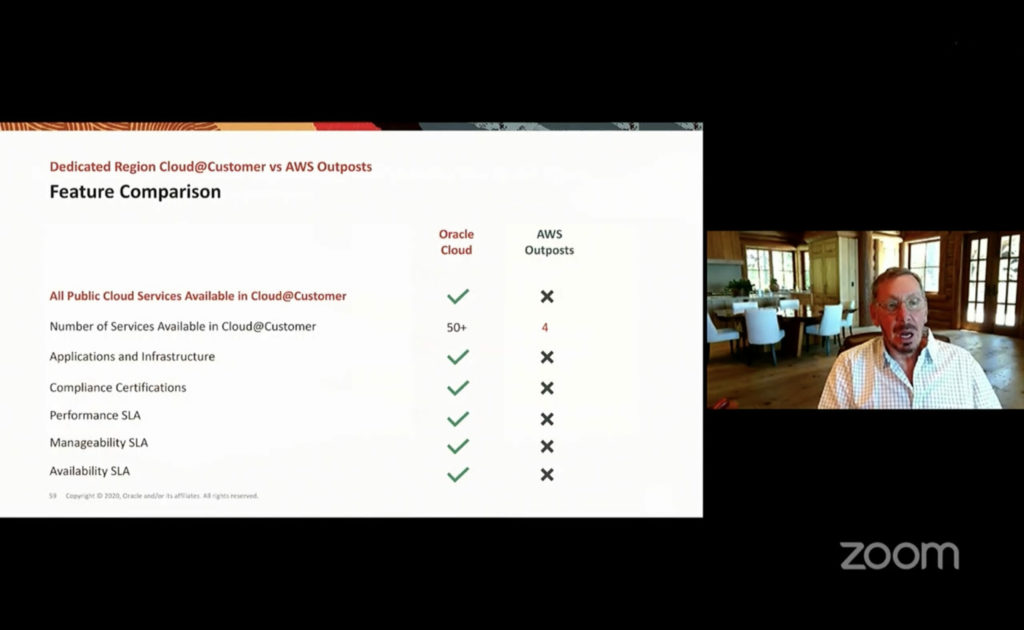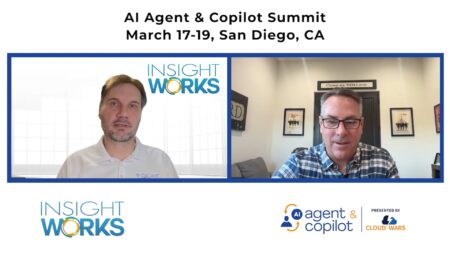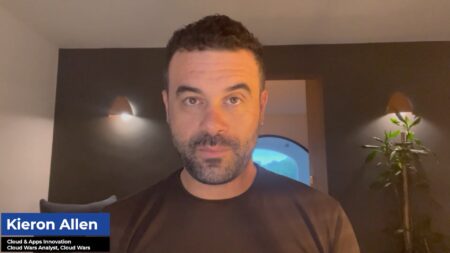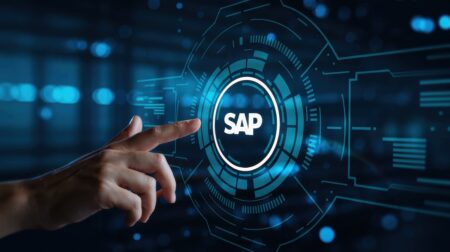In launching some wildly ambitious and highly praised—dare I say revolutionary?—cloud services last week, founder Larry Ellison clearly made “autonomous” the third strategic front in Oracle’s long-term plan to beat Amazon.
In an hour-long Zoom presentation (gotta showcase those great customers, right?), Ellison delivered one of his most compelling and comprehensive narratives about Oracle’s prospects for moving from the extreme fringe in the IaaS wars to the heart of the battle with Amazon, Microsoft and Google Cloud.
Among the key points made by Ellison:
What makes “Oracle Gen2 infrastructure” deserve its name.
For the first time, Ellison offered a clear definition of what Oracle means by the “Gen2” label it has long used but rarely defined. In the past, it was a vague reference to being newer or better or cooler, and that vagueness gave it something of a pink-unicorn feel. But in his online Oracle Live presentation last week, Ellison swept aside the vagueness and stated unequivocally that Gen2 = autonomous.
Early in the hour-long presentation, Ellison said, “Before we announce the new products, I’d like to just update you on the progress Oracle’s Generation 2 Cloud is making in the marketplace. Now, we call our cloud a second-generation cloud because of one thing: because of autonomous services. The difference between a Generation 1 Cloud and a Generation 2 Cloud are these autonomous services.” And that for Oracle, that means not just its Autonomous Database but also all of Oracle’s growing arsenal of autonomous cloud technologies and services: infrastructure, database, Linux and more.
As Ellison hammered home on more than one occasion, “No one else offers anything like this.”
Customers are buying faster than Oracle is talking.
In the past several years, Oracle has had the unfortunate tendency to describe great, sweeping and marvelous cloud plans and visions without, in fact, having the goods to back up the talk. But with its new autonomous services and Cloud@Customer approach, Oracle has been able to bring customers aboard early and increasingly often with real, high-impact cloud solutions. The list of early-adopter customers is impressive and I’ll share that in a future piece.
Ellison talked in great depth about hybrid cloud but *never* said the word “hybrid.”
True to his nature of assiduously avoiding the pack, Ellison spoke convincingly about Oracle’s strategy for allowing customers to deploy a unified set of technologies and solutions across the worlds of cloud (in all its variations) and on-premises.
Every other tech company calls this “hybrid computing,” with IBM leading the way. (IBM seems to have a mandate that its executives must use the term “hybrid” at least two times in every sentence they utter in any public commentary. CFO Jim Kavanaugh recently dropped the H-bomb 25 times in just the *opening remarks* on an earnings call.) But I digress: my point is that Ellison is looking to redefine this massive and highly strategic category by rigorously avoiding the term “hybrid” and instead focusing on the massive business value customers can unlock by having a consistent, secure and high-performance set of IT tools across cloud and on-premises.
Amazon’s AWS cloud unit can’t match the wide array of sophisticated new tools Oracle has unleashed.
Ellison pointedly highlighted what he described as gaping disparities between Oracle’s cloud technologies and capabilities and those of AWS. While some or perhaps most or maybe even all of these claims made by Ellison are true, please bear in mind that AWS has an enormous lead on Oracle in the IaaS market, and that it would require a Herculean effort by Oracle to approach even half of the IaaS market share AWS has.
For years, Ellison has been proclaiming that Oracle will catch and overcome AWS, and for years, no such thing has come close to happening. BUT—for the first time, it seems like Oracle has achieved superiority over AWS with the focus on autonomous, and with the visionary new Cloud@Customer services Ellison revealed. For full details on those announcements, please check out my analysis from late last week: Larry Ellison’s Miracle: Oracle Becomes Big-Time Cloud Infrastructure Player. Below, I’ll share the specific claims of superiority made by Ellison.
A matter of priorities: before talking technology, Ellison profiled numerous customer stories.
To me, this was a startling and welcome change from Ellison. When he’s announced new products in the past, customer stories were jammed in at the end or omitted completely. But last week, Ellison spoke about customer deployments at the very top of his remarks. That could be just a coincidence, but I’m pretty sure it’s a reflection of a new focus on customers and customer successes for Oracle.
Ellison’s verbatim claims of how and why Oracle Gen2 technology is superior to that of AWS
- “Today, in July 2020, Oracle Corporation has 24 cloud regions around the world, identical to the number of cloud regions that AWS has. A year from now, Oracle will have 36 Generation 2 Cloud regions around the world versus the plan that AWS or Amazon has released for 27 cloud regions. So we’re growing our public cloud very, very rapidly.”
- “Another company also in the business of online meetings is a company called 8×8. Now, 8×8 used to run entirely in Amazon before they evaluated the Oracle Gen 2 Cloud infrastructure. And 8×8 concluded they could save a huge amount of money, get better price-performance and better security by moving entirely from Amazon to Oracle’s public cloud… Another new customer for Oracle Gen 2 Cloud is McAfee. McAfee of course is a leader in cyber security, and they actually support half a million events per second on our cloud infrastructure. And what they noticed was it’s 75 percent less expensive to run their cyber security application on Oracle’s Gen 2 Cloud than any other cloud provider…
And you’ll see this theme over and over again, that Oracle delivers better price-performance. So it’s much cheaper to run their application in the Oracle Cloud than any other cloud provider. That’s why a lot of people are moving from their current cloud provider to the Oracle Gen 2 Cloud.” - “Last year, Amazon lost data on 100 million Capital One customers. Now, this happened because Amazon’s databases—all of them: Aurora, Dynamo, RedShift, RDS, etc.—all of them require complex manual provisioning, manual configuration, manual encryption, turning on backup, turning on security, turning off security, doing all of these things. It’s very complicated. And human beings who are running these clouds are dealing with a very complex system. And human beings can make mistakes. They can misconfigure a system, which is one example that causes huge amounts of data loss. Or they can forget to patch a system, to make an error of omission, just miss something. And that can also result in huge amounts of data loss…
Contrast that with the Oracle Autonomous Database where provisioning is automated. Configuration is automated. You cannot make a configuration error with the Oracle Autonomous Database because it’s entirely automated.” - “So performance and cost are one-to-one correlated. We run twice as fast, and your bill is cut in half… And that’s why we’re very confident to guarantee that, if you move your application from Aurora and AWS to Oracle or Redshift to Oracle, you will more than cut your Amazon bill in half. We’ll guarantee that. And, again, a lot of our new customers came to Oracle after testing Oracle’s performance versus Amazon and seeing they get dramatically better price-performance, which meant what they’re paying for their cloud services went down, again, dramatically.”
- Discussing Oracle’s fascinating new Dedicated Region Cloud@Customer service: “Everything in the Gen 2 Public Cloud we drop and put inside your data center behind your firewall. And I mean everything—Fusion applications, the Autonomous Database, Autonomous Linux, Autonomous Data Guard—and Oracle manages it and maintains it. There’s one console for managing the Dedicated Region, the Public Cloud, and Exadata Cloud@Customer.
You manage all of your Oracle Gen 2 cloud assets in the same exact way, with a single management console. The SLAs with public cloud apply unchanged to dedicated region. You only pay for what you use…. No one — not Amazon, not Microsoft, not Google — nobody gives you a complete public cloud behind your firewall, dedicated to you. This is a first in the cloud industry.” (emphasis mine).
Final thoughts
If Oracle can fulfill this early promise and become a true high-impact competitor in the IaaS market, business customers will benefit greatly from that heightened and intensified level of competition. Meanwhile, other cloud vendors will in turn create better and more-innovative solutions. So in that context, I’m rooting for Oracle to fulfill that early promise and deliver the goods for customers.
But even if that happens—and I believe it will—we don’t live in a steady-state world. Amazon and Microsoft and Google will all continue to deliver their own startling and powerful innovations. Again, all of that is great for customers.
Oracle’s off to a great new start here—but the Cloud Wars are both a sprint and a marathon. So Ellison and company need to get lots and lots of customers committed to its Gen2/autonomous approach quickly, and it needs to begin cooking up its next wave of innovations even as Dedicated Region Cloud@Customer is just rolling into production.
Such is life—and leadership—in the Cloud Wars here in mid-2020.
RECOMMENDED READING
Larry Ellison’s Miracle: Oracle Becomes Big-Time Cloud Infrastructure Player
Oracle and Larry Ellison Go Silent on Snatching Huge SAP Customers
10 Reasons Larry Ellison Believes Oracle Can Beat Amazon and Microsoft
Hey Larry Ellison: Microsoft’s #1 Priority Is Replacing Oracle Database
Can Larry Ellison Turn Zoom & Autonomous DB into Big-Time Oracle Cloud Revenue?
Oracle-SAP Showdown: SAP Calls BS on Larry Ellison Claim of Snatching Huge SAP Customer
SAP Has Twice as Many Cloud ERP Customers as Oracle: Exclusive Co-CEO Interview
Subscribe to the Cloud Wars Newsletter for in-depth analysis of the major cloud vendors from the perspective of business customers. It’s free, it’s exclusive and it’s great!








